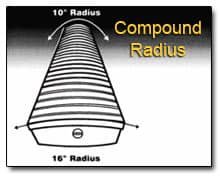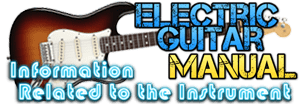COMPLETE GUIDE to the Different Curvature Radius of the Electric Guitar Fingerboard: Characteristics, Qualities, Advantages and Disadvantages.
Sometimes when buying our first guitar or buying a new one for our collection, we don’t pay attention to the radius of the fretboard. But each radius has qualities and disadvantages that guide the characteristics of each type of electric guitar.

If we were to extend the slight curvature of the tuning fork until both points meet again, we would obtain a circumference. Obviously, the size of this circle would be greater as the fingerboard is flatter, and the circumference would be less if the fingerboard has a more rounded shape.
To differentiate each fingerboard radius, the measurement of the radius of this circumference would be taken as a reference. Consequently, the smaller the measurement of the radius, the greater the curvature of the fretboard, and the larger the measurement, less curvature. Since by increasing the radius, the resulting circumference would also be increased, and for this reason the curvature of the fingerboard is reduced.
Fingerboard Radius on Guitar, Curved or Flat?
In general, the most curved fingerboards would be oriented towards rhythm guitarists, and the flattest ones to lead guitarists. Although we can also do solos with a guitar with a curved fingerboard, and put chords on flatter fingerboards.
The problem for a solo guitarist using a highly curved fingerboard is that the bends can mute, or even die out halfway through, when bending the string. Since the curvature of the fingerboard itself can cause the string to rub or even touch the upper part of the frets. Appearing mainly this problem in the central area of the neck.
The most logical and simple solution to solve this problem would be to increase the height of the strings, with which the solo guitarist would lose part of the necessary comfort to play passages with a certain speed, or with high technical difficulty.
Instead, chords would sit more comfortably on a rounder fingerboard than on a flatter one. Since the hand more comfortably wraps the neck when making chords.
Fretboard Radius on Fender Guitars
Curved fingerboard radius are characteristic of Fender-style models like Telecasters, or even Stratocasters, since it would be very common to find vintage models with a 7.25″ fretboard radius.

Although modern models of both the Telecaster and the standard Stratocaster usually have a 9.5” fingerboard, like other Fender designs such as the Jazzmaster or the Mustang. A somewhat more versatile fingerboard range than the vintage 7’25” models.
Fretboard Radius on Gibson Guitars
Due to its versatility, the most commonly used fingerboard radius by guitar makers today is 12”.

The 12″ fingerboard radius is characteristic of Gibson models like the Les Paul or SG, although we can find Strat models like the G&L Tribute Legacy, or the Godin Session with a 12″ fretboard radius (image above).
Guitars with a certain orientation towards solo guitarists have an even flatter fingerboard radius of 14” like the ESP LTD ST-213, or the Schecter Omen Extreme.

Guitars with a clear solo character such as the Ibanez, Cort or Jackson models, the radius can reach 16”.
Fingerboard Compound Radius

Mixed fingerboard radius were developed for greater versatility, producing a fingerboard with a more rounded top and flatter bottom.
Thus we will have a little more comfort when placing open chords in the upper part of the neck, and at the same time the advantages of a flatter fingerboard in the lower part, to favor the solo guitarist.
For example, Jackson guitar pictured below has a mixed radius of 12 and 16 inches.

Fingerboard Radius Gauges
You can build your own calipers yourself, with the templates that appear at the bottom of the page.
With this tool you can find out what fretboard radius a neck has. You can also use these gauges, to give the strings the same curvature as the fingerboard.
The one in the image is made of PVC cut with a fret saw, and sanded to remove burrs and to make it even.

You will only have to print the templates, and then transfer them to thick cardboard, sheet of wood or plastic. Download in PDF.
In the pdf file there are radius from 7.25 inches, up to 20”.
Fretboard Radius Gauges Templates

